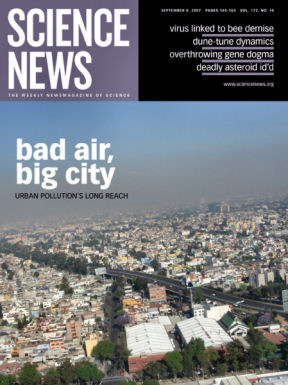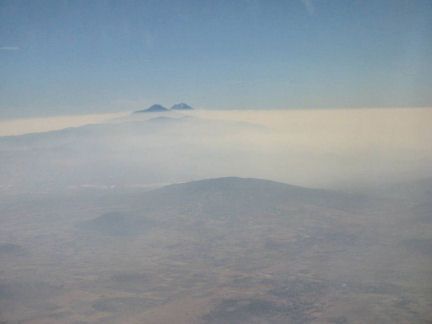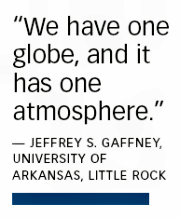Jeffrey S. Gaffney, a sunburn-prone atmospheric scientist, set off one morning in March 2006 for a day of field work in Mexico City—without his hat and sunscreen. At Mexico City’s altitude, 2,240 meters above sea level, sunlight beating down through the thin air delivers as much as 30 percent more ultraviolet radiation than reaches coastal regions. “I thought I’d be fried at the end of the day, for sure,” he recalls.




But Gaffney, a researcher at the University of Arkansas in Little Rock, came through the day unscathed. The sunburn that he’d feared never developed because much of the sun’s ultraviolet radiation was blocked by the city’s notoriously dirty air. Some of the radiation was scattered back to space by the high-altitude haze smothering the city; some was absorbed as it stimulated chemical reactions within that soup of pollutants.
He and more than 450 other researchers from Mexico, Europe, and the United States had come to Mexico City for a monthlong study of air pollution in, above, and around the metropolis. The MILAGRO campaign—the Megacity Initiative: Local and Global Research Observations—was designed to scrutinize local and regional air quality, the effects of pollutants on human health, and the influence of Mexico City’s pollution on regional and global climate. Mexico City, whose 20 million inhabitants endure constantly nasty air, was an ideal study site.
Any urban area with more than 10 million residents is considered a megacity. Many studies suggest that these gigantic urban areas have become the world’s dominant sources of atmospheric pollutants. Some of their emissions are long-lived and apt to drift far from home. Pollution from Asian megacities routinely wafts to North America (SN: 12/12/98, p. 374; SN: 1/1/00, p. 4). Other research suggests that as much as one-third of the low-altitude ozone in some parts of Europe originates in North America.
MILAGRO data will enable scientists to better understand how air pollution evolves, says Gaffney. Increasingly, field studies and lab experiments indicate that the color, chemical reactivity, and other characteristics of airborne particles and droplets can change dramatically over time. Such findings may eventually affect how such pollutants are regulated.
Because Mexico City is the world’s second-largest megacity, many of the problems observed there may foreshadow troubles to come in smaller, rapidly growing urban areas throughout the world. On the other hand, computer simulations suggest that many smaller megacities export a proportionately higher share of their pollution to distant regions even than Mexico City does.
A growing problem
In 1800, only 3 percent of the world’s population lived in cities. Today, more than half of our planet’s 6.6 billion people reside in urban regions. By 2030, if forecasts by the United Nations are correct, three-fifths of the world’s projected population of 8.3 billion will live in cities.
The growth of population in cities leads to increased energy consumption within relatively small areas, a trend that typically decreases air quality and increases the prevalence of adverse health effects, says Luisa T. Molina, an atmospheric scientist at the Massachusetts Institute of Technology. Those consequences are particularly pronounced in Mexico City, she noted in May at a meeting of the American Geophysical Union in Acapulco, Mexico. In recent years, for example, ground-level concentrations of ozone in Mexico City have exceeded the country’s air-quality standards 284 days per year, on average. Geography doesn’t help: Mexico City lies in a broad basin ringed by tall mountains that can block the movement of air masses that might clear out pollution.
Furthermore, the city’s rapid spread in recent decades has aggravated its pollution problems. Mexico City now covers about 1,500 square kilometers—about 10 times as much land as it occupied just 50 years ago, says Molina. That sudden sprawl, coupled with unregulated land use, has translated into a drop in population density that has in turn necessitated people and goods moving greater distances throughout the metropolis, says Luis G. Ruiz-Suarez, an atmospheric scientist at the National Autonomous University of Mexico in Mexico City. Many residents commute long distances through areas that lack mass transit.
All told, the 3.5 million vehicles traveling in and around the Mexico City area burn about 40 million liters of fuel each day. Their emissions, along with those from power plants, agricultural burning, and other sources, render the air over the city a noxious stew.
Hence the need for the MILAGRO campaign, the first comprehensive, multinational effort to assess the impact of a megacity on regional and global air quality, says Molina. To supplement observations from orbiting satellites and from ground stations throughout the city, MILAGRO-project scientists flew six sensor-laden aircraft, and even one ultralight craft, through plumes of pollution at various altitudes.
The researchers relied on a variety of chemical fingerprints to identify pollution sources, says James J. Schauer, an atmospheric scientist at the University of Wisconsin–Madison who participated in the study. For example, burning cellulose produces levoglucosan, which accounts for about 15 percent of the organic carbon in particles wafting from wood and grass fires. This substance doesn’t degrade in the atmosphere. Combustion of fossil fuels, such as diesel, gasoline, and coal, produces hopanes, a group of hydrocarbons with multiringed structures. By determining the atmospheric concentrations of such chemicals, Schauer and his colleagues could divvy up the blame for Mexico City’s pollution.
One of the group’s sampling sites was in a downtown area near major traffic arteries and residential, commercial, and light-industrial neighborhoods. Gasoline-burning motor vehicles generated about 47 percent of the light-colored aerosols containing organic carbon collected at the site, while diesel engines produced some 88 percent of the dark-colored aerosols, Schauer and his colleagues report in an upcoming Atmospheric Chemistry and Physics. Pollution was particularly bad during morning rush hour, when traffic moved slowly, if at all, they note.
Pollution was lighter at a site about 35 km northeast of the downtown site, in an agricultural area on the city’s fringe. Over the course of a day, motor vehicles were the largest contributors to air pollution. About 31 percent of the organic-carbon aerosols and 82 percent of the dark-colored aerosols came from gasoline- or diesel-powered engines, data suggest.
Amounts also varied over time. Gasoline-powered vehicles accounted for 37 percent of the organic-carbon aerosols measured downtown on weekdays but 67 percent of those collected during weekends. Air samples collected during nighttime hours contained an estimated 13 percent fewer diesel emissions.
Wood smoke was another prevalent pollutant. Downtown, it was second only to vehicle emissions, says Schauer. At times, it accounted for as much as 30 percent of the organic aerosols, he adds. At the rural site, it sometimes accounted for 50 percent of organic aerosols.
Variations during the day in the concentrations of wood smoke measured downtown did not correlate with those seen at the rural site, indicating that wood-smoke pollution in the two areas probably came from different sources, says Schauer. Downtown, it may have derived from wood-fueled fires used to cure tiles or adobe bricks. At the rural site, the increased concentrations of nanometer-size, unburned fragments of plant material in smoke samples suggest that the smoke came from brush and grass fires, says Schauer.
Chemical evolution
Researchers couldn’t identify pollution sources for a significant fraction of the organic-carbon aerosols detected during the MILAGRO campaign. Many of those particles were probably secondary organic aerosols (SOAs), which form in the atmosphere as a result of chemical reactions among various pollutants. Sunlight often stimulates such reactions.
During the field study, concentrations of SOAs varied dramatically, Schauer says, from as little as 6 percent of organic-aerosol samples at the downtown site at some times of day to as much as 63 percent at others. One SOA, pinonic acid, forms in a reaction between oxygen and alpha-pinene, a chemical given off by certain species of trees and other plants. Atmospheric concentrations of pinonic acid typically spiked just a few hours after the researchers detected a rise in wood smoke, suggesting that wood-fueled fires were the source of this pollution.
The MILAGRO data contain clues to many such transformations, says Gaffney. Observations from aircraft were particularly revealing. Early in the morning, haze over the city tended to be dark, a sign of diesel exhaust. As the day progressed, the aerosols reacted with other pollutants in the air and became lighter in color, scattering more light than they absorbed. “These reactions are rapid and probably take place within a couple of hours,” Gaffney notes.
MILAGRO and other atmospheric studies provide opportunities to better understand the formation, evolution, and transport of SOAs. Gaffney and his colleagues observed, for example, that because the thick, high-altitude haze prevented much of the sun’s ultraviolet light from reaching ground level, pollutants there didn’t react with each other as quickly as they would have under sunny conditions. So, Gaffney says, SOAs often didn’t form until their ingredients wafted out to the surrounding region, where skies were relatively clear.
Such implications, coming from MILAGRO and other recent field studies and lab experiments, are revolutionizing air-quality research, says Neil M. Donahue, an atmospheric chemist at Carnegie Mellon University in Pittsburgh. “The study of air pollution has been flipped on its head in the last year,” he notes.
In particular, SOAs are turning out to be a much bigger problem than scientists had previously realized. As Allen L. Robinson, also at Carnegie Mellon, puts it, “Pollutants that come out of the tailpipe aren’t the only ones you need to worry about.”
Experiments by Donahue, Robinson, and their colleagues indicate that current models may drastically underestimate the extent of air-pollution migration from cities. They released diesel exhaust into a 12-cubic-meter, Teflon-coated chamber and zapped it with enough ultraviolet light to simulate radiation exposure on a summer day.
After 3 hours, the number of aerosols in the chamber had approximately doubled, says Robinson. The researchers then added what they thought would be enough toluene to again double the SOA count. Toluene is a hydrocarbon of modest molecular weight, used as an octane booster in some fuels, and thought to be an important source of SOAs. As it turned out, aerosol concentrations barely budged. Results were similarly negative when the scientists added other common pollutants, the team noted in the March 2 Science.
Contrary to prior belief, the recent experiments suggest that emissions of small hydrocarbon molecules actually account for only 15 percent of SOAs. Instead, the researchers suggest, most SOAs come from the oxidation of long-chain hydrocarbons that scientists had previously assumed would remain inert, says Robinson. When his team incorporated these new processes into computer models that simulate the formation and spread of air pollution, they found a 15- to 30-percent rise in pollution in rural areas downwind of cities.
Most such simulations consider the reactions among, at most, a few dozen atmospheric gases and pollutants. However, emissions from tailpipes and smokestacks typically contain hundreds, if not thousands, of hydrocarbons and other compounds. They have “so many different molecules, it’s a soup,” says Robinson. Scientists, he notes, are increasingly recognizing SOAs as “unpleasant surprises.” In fact, SOAs probably account for the majority of pollutants to which people are exposed. Robinson and his colleagues suggest that air-quality regulations may need to be revised to account for the most common SOAs.
Big footprints
Megacities, despite their sprawl, occupy a relatively small part of the landscape. Even so, the air masses driven by Earth’s weather systems can carry a megacity’s pollution thousands of kilometers.
Some atmospheric pollutants have extremely short lifetimes. Nitrogen oxides, for example, which form as by-products of fossil fuels burned at high temperatures, last only a couple of days before they react with other substances, says Tim M. Butler, an atmospheric chemist at the Max Planck Institute for Chemistry in Mainz, Germany. Ozone, on the other hand, persists in the atmosphere for an average of 25 days and can waft across oceans.
Because wind spreads air pollution, a region’s weather patterns dictate whether its megacities are aggressive exporters of bad air. Butler and his colleagues have used computer models to simulate how pollutants with various atmospheric lifetimes would spread from 30 large urban areas, including 20 megacities, throughout the world. Although pollution concentrations vary among the megacities, the researchers assumed that each urban area emitted a total of 1 kilogram of pollutant per second. The researchers also tracked whether the simulated pollutants rose to high altitudes or remained near ground level.
On average, about 5.5 percent of a pollutant that lasts for 10 days in the atmosphere would remain at altitudes below 1 km and travel more than 1,000 km from Mexico City, the team found. Eventually, such substances could show up at concentrations exceeding 10 nanograms per cubic meter across an area of more than 1.2 million km2. That’s an area about 800 times as large as the city itself, but it’s a small reach compared with that of pollution plumes from most other megacities, Butler and his colleagues report in the July 26 Atmospheric Chemistry and Physics.
The simulation’s biggest exporters of bad air were cities at middle and high latitudes, where weather systems less frequently lift pollution to high altitudes, says Butler. Relative to its amount of emissions, the worst long-distance polluter was Moscow. More than 34 percent of a pollutant with a 10-day lifetime would travel more than 1,000 km from that city. Over time, such a pollutant could be found at concentrations of 10 ng/m3 or higher across more than 11.1 million km2, an area larger than all of Europe.
Long-lasting pollutants would eventually spread to cover the entire Northern Hemisphere, Butler notes. These include carbon monoxide, for example, which lasts about 60 days. Substances that last months or years, such as methane, would travel farther and diffuse worldwide.
Results of such simulations, as well as data from satellites and field studies such as MILAGRO, highlight the simple fact that, as Gaffney says, “We have one globe, and it has one atmosphere.”






